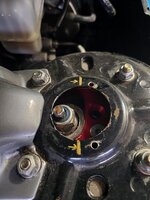Looking into the idea of setting my camber before and after track days instead of the set it and forget it system I’ve going with now to hopefully reduce camber wear on street tires. If doing so is as easy as I’m hoping I will probably be buying vorshlag plates
My idea is if I set the camber at max negative camber with 0 toe (track setup) then when in bring the plates back to minimum camber (street setup) it would add toe
this whole plan fall apart if adding positive camber adds toe out…
I’m thinking a small amount of toe in for the street will be fine.
My idea is if I set the camber at max negative camber with 0 toe (track setup) then when in bring the plates back to minimum camber (street setup) it would add toe
this whole plan fall apart if adding positive camber adds toe out…
I’m thinking a small amount of toe in for the street will be fine.













